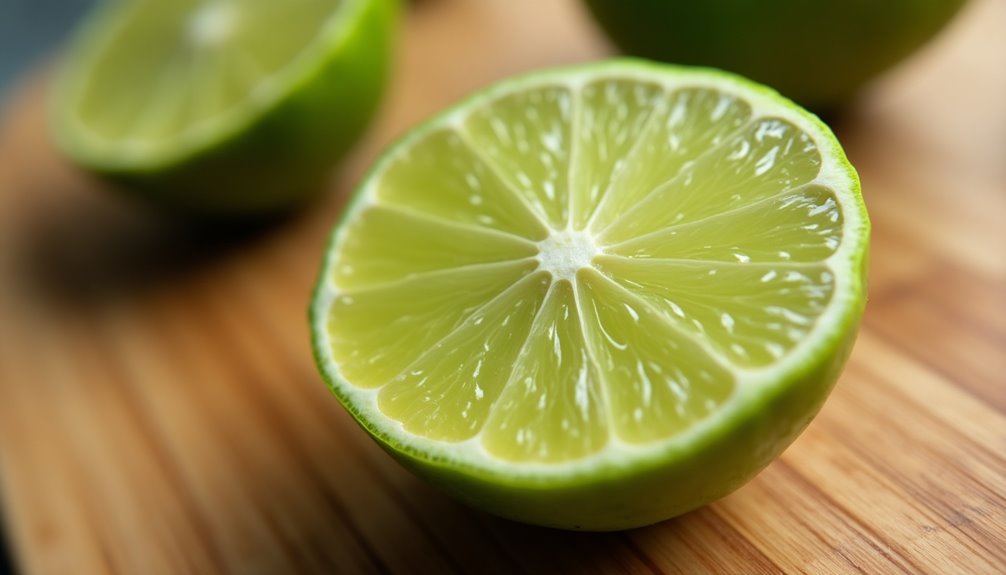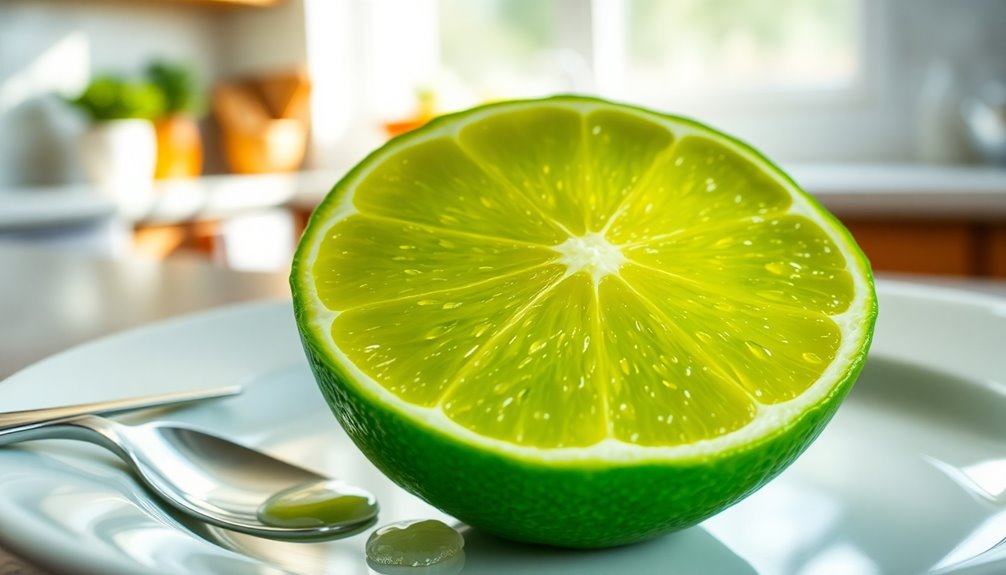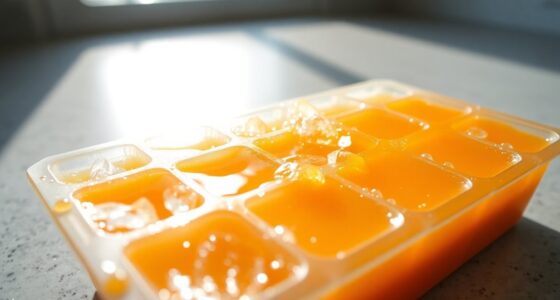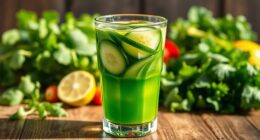Half a medium lime typically yields about 1 tablespoon of fresh juice, which is around 0.5 ounces. This amount is perfect for recipes that need just a bit of zest, like ceviche or salad dressings. Ripe limes will give you more juice, while smaller or unripe ones might produce less. By measuring carefully, you can enhance your culinary creations with the right balance of flavor. Discover even more tips about using lime juice effectively to elevate your dishes.
Key Takeaways
- Half a medium lime yields about 1 tablespoon of fresh lime juice, approximately 0.5 ounces.
- The average yield from a whole lime is about 2 tablespoons of juice.
- Juice yield can vary based on the size and ripeness of the lime.
- Ripe limes typically yield more juice than smaller or less ripe ones.
- Fresh lime juice enhances flavors in dishes, making precise measurements important.

When you're whipping up a recipe that calls for lime juice, you might wonder how much juice you'll get from half a lime. You'll be pleased to know that half a medium lime typically yields about 1 tablespoon of fresh juice, which is around 0.5 ounces. This measurement is handy, especially in recipes that require precise amounts of lime juice to enhance flavor without overwhelming other ingredients.
If you think about it, the average juice yield from a whole lime is about 2 tablespoons. So, when you're juicing limes, using half a lime gives you a straightforward measurement, making it perfect for those occasions when you need less juice. This can be especially useful in cocktails, marinades, or dressings where you want just a hint of that zesty lime flavor.
When you're preparing a dish that requires lime juice, like a refreshing ceviche or a zesty salad dressing, half a lime is often sufficient to achieve the desired flavor. It strikes a balance, allowing you to enjoy that fresh, tangy taste without it overpowering the other ingredients. Moreover, it's a great way to use limes without waste, as sometimes you only need a small amount to elevate your dish.
Keep in mind, though, that the juice yield can vary slightly based on the size and ripeness of the lime. A ripe lime is likely to yield more juice than a smaller or less ripe one. So, while 1 tablespoon is a reliable estimate for half a lime, if you're dealing with particularly juicy limes, you might find yourself with a little extra juice. Conversely, if your lime feels firm or isn't quite ripe, it may yield a bit less.
When you're measuring lime juice, it's also helpful to remember that the flavor profile can change based on how you incorporate the juice into your recipe. If you're making a cocktail, for instance, you might want to add the juice from half a lime gradually, tasting as you go. This way, you can ensure that the lime flavor complements the other ingredients without becoming too overpowering.
Frequently Asked Questions
How Much Juice Is Half a Lime?
When you're juicing a lime, you can expect half of a medium lime to yield about 1 tablespoon of juice, which is roughly 0.5 ounces.
Of course, this can vary a bit based on the lime's size and juiciness. To get the most juice, roll the lime on the counter before cutting it.
Using a handheld juicer helps you extract every drop, ensuring your dishes and drinks get that bright, zesty flavor.
How Much Bottled Lime Juice Equals 1/2 Lime?
Did you know that half a medium lime typically yields about 1 tablespoon of juice?
So, if you need a substitute for 1/2 lime, 1 tablespoon of bottled lime juice will do the trick.
Just keep in mind that the flavor might differ slightly since bottled juice is pasteurized.
It can be a quick and easy alternative, but you might want to adjust the recipe a bit to match the fresh lime's vibrancy.
Can I Substitute Bottled Lime Juice for Fresh Lime Juice?
Yes, you can substitute bottled lime juice for fresh lime juice, but keep in mind that the flavor mightn't be as vibrant.
Bottled juice often has a more muted taste due to pasteurization. When you're replacing fresh lime juice, try using about 2 tablespoons of bottled juice for half a lime, but adjust based on your taste preferences.
If possible, opt for organic bottled lime juice for better flavor without artificial preservatives.
How Many Ounces Is a Half of a Lime?
When you're wondering how many ounces are in half a lime, you can expect about 0.5 ounces.
Typically, a whole lime gives you around 1 ounce of juice, so half will yield half of that.
This measurement's helpful, especially if you're mixing drinks or cooking.
Just remember, the actual amount might vary slightly based on the lime's size and ripeness, but 0.5 ounces is a solid estimate for your needs.
Conclusion
When you squeeze half a lime, you typically get about 1 to 1.5 tablespoons of juice, just like pouring a splash of sunshine into your dish. This bright acidity can elevate your recipes, cocktails, and dressings, bringing everything to life. So, next time you reach for that lime, remember, its juice can work wonders, adding a zesty kick that dances on your taste buds. Enjoy experimenting with this simple yet powerful ingredient!
Cindy thoroughly researches juicing trends, techniques, and recipes to provide readers with practical advice and inspiration. Her writing style is accessible, engaging, and designed to make complex concepts easy to understand. Cindy’s dedication to promoting the advantages of juicing shines through her work, empowering readers to make positive changes in their lives through the simple act of juicing.











